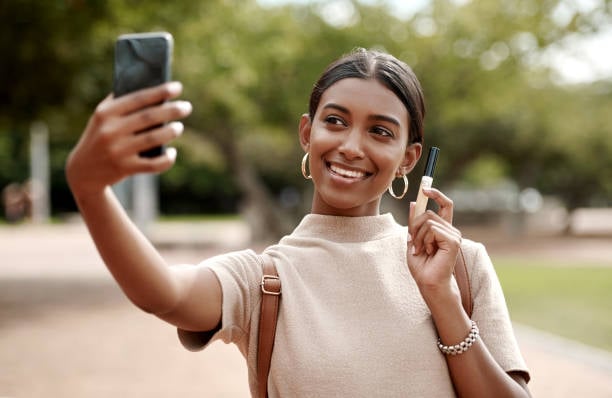January 30, 2023
 by Trelawney Erwin / January 30, 2023
by Trelawney Erwin / January 30, 2023

So, you’re ready to delve into the world of influencer marketing.
Or you’re looking to improve your current influencer marketing strategy. Whatever the case, we’ll break down the steps you need to take to pull off an effective campaign in today’s online social climate.
The first step is to grasp what influencer marketing is, its pros and cons, and why your brand should give it a whirl. Once you’ve got your foundational knowledge, it’s time to start building your strategy.
It’s tempting to start searching for influencers and proposing a collaboration immediately. But as with any marketing campaign, you need to know what you’re trying to achieve first. Influencer campaigns can have a variety of objectives. You may wish to:
You’ll also want to decide how to measure success. Developing key performance indicators (KPIs) will help you determine the campaign’s performance and – perhaps more importantly – how you will adjust to optimize your results.
If you want to improve brand awareness, your KPIs might include the number of views an influencer’s post gets. For engagement, you may wish to look at the growth of your audience or followers, as well as likes and comments on specific posts.
Some other KPIs to measure the success of your influencer marketing campaign include:
And anything else that may give you insight into the success of your campaign.
Tip: When measuring conversions and referral tracking, it’s important to provide your influencers with UTM tracking links so you can easily determine which traffic or sales came from which influencers.
Once you know what you want to achieve with your influencer marketing strategy, you can decide on your budget. Are you going to pay a flat fee or use a performance-based payment system? Many larger influencers charge a flat fee. Others have room for negotiation, and others still accept performance-based payment.
How much should you budget for your campaign? That depends on the type of influencer you want and how many influencers you intend to work with. While there’s no standard budget guide for influencer campaigns, there are estimated prices for the different types of influencers.
Source: Influencer Marketing Hub
Typically, the rate an influencer charges will correspond with their follower count. And different platforms may come with different prices.
Here are some common, current influencer rates in USD:
As you can see, each tier has a wide range of price points. The type of collaboration you’re seeking will impact the price as well. An Instagram shoutout will likely cost you less than a full-fledged review on the same platform. Some influencers will have bundled pricing for ongoing collaborations or a series of posts.
Determining the type of influencer you’re hoping to partner with will help you define your budget. This brings us to step 3.
It’s finally time to start researching influencers and reaching out! As discussed, your budget will have an impact on the types of influencers you seek out. But so will those initial goals you set in Step 1.
There was a time when most companies believed they should always aim for the influencers in the highest follower tier that their budget allowed. Would it make the most sense if you could afford to hire influencers with millions of followers?
Maybe. If your goal is getting a post about your brand in front of the most people possible, this may be a strategy you want to try out. But as influencers become more popular, this technique has lost its luster.
Source: Shopify
If you’re looking for engagement or conversions, you’re better off choosing influencers with smaller followings. Nano- and micro-influencers (1K-50K followers) are starting to have the highest engagement rates (you can use an engagement rate calculator to check) of any other influencer type.
This can be for several reasons.
You also want to make sure your influencers align with your brand values, image, and – of course – product. Partnering with an influencer known for video games is likely ineffective for a fashion brand. And partnering with someone who frequently shares fast-fashion hauls doesn’t look good for a company championing sustainability and conservation.
There are endless tools available that allow brands to search through social media platforms for content creators and influencers. These can be enticing. After all, it saves hours of your time.
Type in that you’re looking for men on Instagram between 18-25 who live in North America and post in the fashion niche, and then, BINGO! Out shoots a list of users within these exact parameters.
Sound too good to be true? It may just be. Influencer search tools have been very popular but rely on third-party data. With changes being made by major companies to shift away from third-party data, these platforms no longer comply.
This is a problem for influencer marketing as Meta has threatened to sever integrations with influencer marketing platforms that rely on third-party data.
While you can still find a number of these tools, use them at your own risk and discretion. It is becoming an ethical dilemma – which could land you in trouble if your brand values include transparency and ethics – and they could get shut down at any time. You risk losing your ability to integrate with specific platforms. Then you’ll have to completely reconstruct your recruitment strategy.
There are some opt-in search tools on the market. These require influencers to sign up for the platform and create a database of creators based on first-party data. This provides brands with an ethical and compliant way of finding creators to collaborate with. However, you’re limited to the creators who have signed up for that specific platform.
Some social media platforms also provide this for business accounts. Facebook, TikTok, and Instagram all have “Creator Marketplaces” where brands can search for creators to collaborate with. YouTube has a similar program with its BrandConnect feature.
Here’s the fun part! It’s time to let your imagination soar and tell your influencers exactly what you want them to do. There are always the classic campaigns: unboxing videos, writing a blog review, posting a photo with a short caption on Instagram, but what you ask your influencers to do is completely up to you.
Challenge yourself to think outside the box. Are you a sports supplement brand? Ask your influencers to share a video of themselves partaking in an extreme sport like base-jumping, skydiving, or highlining while repping your brand.
Launching a new lip color? Get your influencers to show three unusual ways you can use lipstick.
While influencer marketing was once the “new thing,” it isn’t anymore. Social media feeds are full of sponsored posts. And while you want to make sure posts are authentic and not too ad-like, you also want to stand out from the crowd.
You’re paying good money to work with influencers. Do you want a post nearly indistinguishable from their last five brand collaborations? And chances are the influencers you collaborate with will be excited to do something different and creative.
Don’t give your influencers a pre-written caption to paste, a script to read, or anything you could get simply by hiring an actor. People look to influencers for their personalities, authority, and unique spin on their content. Being overly controlling of the content they create for you results in inauthenticity.
But you do want to be specific in your guidelines. If there’s a link they need to include, let them know. Make them aware of the posting deadline, whether they need to submit it to you for approval first, how many hours of data is collected for paying by performance, and anything else important for your influencers to know.
Being specific upfront mitigates issues later on.
Now that influencer marketing is mainstream, it’s becoming more regulated. Kim Kardashian was recently fined over $1M for not disclosing that she was being paid for a post she made promoting a cryptocurrency firm.
Because influencer marketing is a form of advertising, legal requirements must be fulfilled. Make sure you and your influencers know what needs to be included in a post to be compliant.
Was your campaign a success? It’s time to find out. As your campaign goes live and in the weeks following, you’ll want to collect as much data as possible. Make sure to record:
Having this information allows you to compile metrics such as cost per engagement, acquisition costs, cost per lead, return on investment (ROI), and more.
Refer back to your KPIs to evaluate the success of your campaign, and use the data you’ve collected to decide how to tweak your next campaign for greater success.
Tip: To ensure posts meet your expectations before they go live, ask your influencers to send you their drafted post before posting it online. Also, monitor any live submissions for unforeseen issues so they can be dealt with quickly.
Just because your campaign is over doesn’t mean the benefits stop there. One great part about collaborating with content creators is all the content you can reuse in future campaigns.
Before you repurpose influencer content, make sure your contract clearly and explicitly gives you the rights to do so. Discuss content usage terms upfront and ensure your influencer contract includes licensing clauses that cover republishing, paid ads, and cross-channel promotion. The last thing you want is a disgruntled creator, especially a high-profile one, publicly accusing your brand of misusing their content. Even if you're legally protected, a miscommunication over intellectual property can quickly escalate and damage your reputation.
But once you’ve got the all-clear to reuse content, influencers’ quotes, photos, videos, and more can be valuable; you can:
Source: Brandbassador
Anywhere that you would use branded content, you can use your influencers’ content. But why would you want to?
For one, you’ve already paid for the content in the campaign, so it’s less costly than producing new content. But more importantly, user-generated content (UGC) is more trusted than brand content. Consumers don’t want to see brands talking about how great they are. They want to see people they trust and others like themselves talking about how great a brand is.
But here’s the kicker – influencer content is often trusted less than brand content. So make sure to measure the success of any future campaigns that use influencer content. This tactic may enhance your influencer marketing strategy if you’ve partnered with nano- and micro-influencers.
If you build up a community of brand ambassadors who genuinely love your brand – rather than hitting up a high-profile macro or mega-influencer who’d never heard of your brand before your partnership.
Source: SocialMediaToday
For a long time, Instagram was the social media platform of choice for influencer marketing. But another platform is edging its way into the influencer marketing space: TikTok.
Once thought of as a silly app for teens to show off dance moves, the short-form video platform has exploded into a creator’s dreamland. It’s now the app where everybody who’s anybody needs to be.
Although some people may simply look at TikTok’s popularity and growth as a good reason to use it for influencer marketing, this question is still worth asking for brands. After all, if your niche hasn’t really found its space on TikTok but still thrives elsewhere, it may not be worth shifting a ton of focus and energy into the platform.
Take a look at TikTok’s demographics:
Source: DataReportal
TikTok’s advertising audience is primarily between the ages of 18-34. There are app users above 35, but if this is your target audience and consumer base, TikTok may not be where you want to focus most of your efforts.
If your consumer base is primarily below 35 – particularly if they’re below 25 – TikTok is most definitely worth the effort.
We’ve already talked about age demographics, but now it’s time to find your TikTok niche. Niches within TikTok are commonly referred to as “Tok”s. For example, BookTok is where people post about books and writing. PlantTok is where plant parents and gardening aficionados gather.
The great thing about these niches is that there is a “Tok” for nearly everything. Are you a brand focused on cleaning supplies or organization products? There’s CleanTok. Specialise in baby or children’s products? There’s MomTok.
There’s FashionTok, ArtTok, GameTok, TrainTok, and ShoeTok. There’s even FrogTok. Pick a word, throw “Tok” behind it, and there’s probably a dedicated fan base on TikTok. And most of these fan bases have accounts that could be considered influencers.
Remember FrogTok? User FroggieBiologist has over 130K followers. And Mushi_Frog has 424K. If accounts dedicated to frogs can be that popular, it’s guaranteed that there will be influential accounts within your niche.
@nekogekko Tiny cabbage Suprrmacy 🐸 #frog #frogtok #frogsoftiktok ♬ Breaking Bad Main Title Theme (Extended) - Dave Porter
Source: TikTok
TikTok is a great way to get your brand in front of your audience in an organic way. While you could ask influencers to do a review, unboxing, or a shoutout for your product, the best TikToks are the ones people are already drawn to.
There are tons of TikTok video styles:
Experiment with different styles of video. Explore what’s currently trending in your niche and try it out!
This brings us to the topic of trends. Trends on TikTok are huge but move very quickly. It can be difficult to build a campaign around a particular trend because it may be over by the time the posts go live. But if you can find a trend to relevantly collaborate with an influencer and move quickly, it could explode your reach.
TikTok originally forced everyone to be short and sweet. Like the now-defunct platform Vine, which only allowed 6-second videos, TikTok started off allowing users to showcase their creativity in 15-second spurts.
It extended to 1 minute and then to 3 minutes. Now, TikTok allows users to upload videos up to 10 minutes long. But longer does not always mean more successful.
We already have YouTube for long-form video content. The appeal of TikTok was short videos that captured your attention before you scrolled along to the next one. In fact, short-video content has become so popular that other platforms are now adopting it – Instagram with Reels and YouTube with Shorts.
So what length is ideal? In 2022, one-quarter of the highest-performing videos on TikTok were between 21 and 34 seconds in length. That doesn’t mean influencers can’t make videos any longer, but they should keep them as short as possible while ensuring they cover the required information.
TikTok is a bizarre landscape where unexpected content regularly goes viral. If you’re working with influencers already doing well on TikTok, they know what works.
Don’t hand them a list of rigid requirements that you’ve practically scripted their content. Give them only what you need and let them do their thing. You'll likely end up with content that you wouldn't have thought of and works better than expected.
This also helps you mitigate the issues with trends and video length. Giving your influencers more creative freedom means they can hop on whatever trends are popular while filming. It also allows them the freedom to create a video similar in length to the ones they already see success with.
If an influencer is boxed into your idea of what their content should look like, it may be glaringly different from their usual content. Their followers will notice. It will appear inauthentic, and both you and the influencer may end up with damaged reputations.
Popular TikTok couple Jay and Sharon are known for comedic skits. Their collaboration with Extra Debit Card followed their usual skit format and had nearly 45K likes.
Lifestyle and fashion TikTokker Brooke Woodside, who posts Outfit Of The Day videos, got over 165K likes on this video, showing off her daily outfit. This video wasn’t a brand collaboration, but hundreds of people commented asking what brand and style her shirt and jeans were, drumming up attention and awareness for the brands.
@jayandsharon It's the real deal @extra.card #sponsoredobviously ♬ Rice Crackers - Aves
Source: TikTok
Give your TikTok influencers creative freedom, and the results may just blow you away.
Building an effective influencer marketing strategy requires many moving parts working in tandem. It can be overwhelming, especially if you’re a smaller brand without abundant manpower to lend to your word-of-mouth marketing program.
Luckily, there are ways to simplify the process. There are numerous platforms and tools that centralize everything you need to pull off successful influencer collaborations – from connecting and communicating with influencers to planning and running campaigns, collecting UGC, and rewarding your creators.
What’s next in influencer marketing? See how influencer marketing is rising and what's more in store.
Trelawney Erwin is the copy and content writer for Brandbassador. She specializes in writing about ambassador and influencer marketing trends, strategies, and technology.
In marketing, awareness is not the goal; advocacy is.
 by Jennifer Kim
by Jennifer Kim
Ten years ago, the concept of hiring a social media manager seemed outlandish to most brands.
 by Haley Fraser
by Haley Fraser
There’s no doubt that the relationship between influencer and audience is pivotal.
 by Brandon Brown
by Brandon Brown
In marketing, awareness is not the goal; advocacy is.
 by Jennifer Kim
by Jennifer Kim
Ten years ago, the concept of hiring a social media manager seemed outlandish to most brands.
 by Haley Fraser
by Haley Fraser


